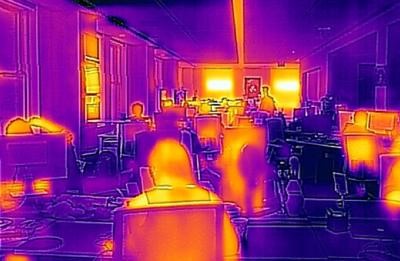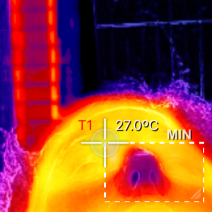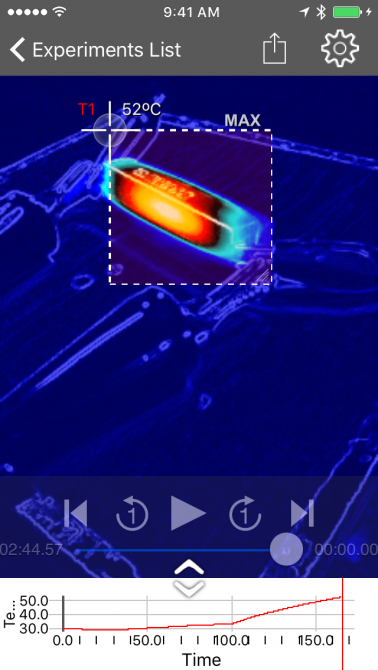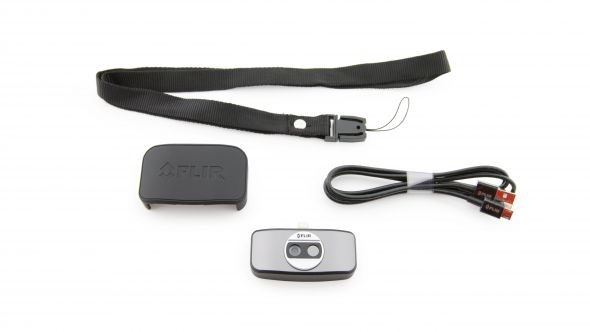FLIR ONE Thermal Imaging Camera
By Edwin P. Christmann
Posted on 2016-10-27
Introduction
The imaginations of middle school and high school students will be fully engaged in the science classroom with the FLIR ONE Thermal Imaging Camera. This camera’s thermal capabilities allow students to explore things invisible to the human eye. For example, students can use the camera to investigate the world of thermodynamics in a manner that parallels the excitement and mystery evoked by sitting on the edge of your seat during a cutting-edge science fiction movie.
How does it work?
What we can see with naked eye is restricted to visible light. Therefore, when you consider the electromagnetic spectrum (EM), which encompasses radio waves, microwaves, infrared light, visible light, ultraviolet light, x-rays, and gamma rays, it becomes evident that what we can see with our eyes is limited. As an example, devices such as military night vision goggles make it possible to see images in the dark. In a similar way, the FLIR ONE Thermal Imaging Camera is a device for us to “see” beyond visible light.
Thermal-imaging cameras, like the FLIR ONE, can “see” heat signatures, which are converted to display variations of temperatures, e.g., How an icy soft drink contrasts with the flame on a candle. This is because all objects emit thermal energy and the hotter the object; the more energy given off by the object. The energy emitted is known as the “heat signature.” Hence, every object has a different heat signature; and it’s those signatures that are detected by thermal imagers like the FLIR ONE. Moreover, since thermal cameras are not concerned with visible light, regardless of lighting conditions, thermal cameras can detect the different heat signatures in a variety of situations. Therefore, images of temperature variations can be observed with this type of device.
FLIR ONE Thermal Imaging Camera Compatibility
The Thermal Camera is made for the iPhone and the iPad. It is very easy to use and, because no interface is needed, it is a snap to use in the classroom. Subsequently, teachers will have no problem having students connect the device for experiments. The first step, however, is load the free Vernier Thermal Analysis for FLIR ONE application, which is available for download on the iTunes App Store [https://itunes.apple.com/us/app/vernier-thermal-analysis-for/id1083139486?mt=8]. It requires iOS 9.0 or better and should be installed before connecting the camera to your device. The Vernier Thermal Analysis for FLIR ONE application is simple to access and takes only a few minutes to upload.
As explained in the iTunes store:
“Vernier Thermal Analysis for FLIR ONE allows you to mark up to four locations or regions on a thermal image. In a selected region, you can determine minimum, maximum, or average temperature. Graph temperature data live during an experiment, then export to our Graphical Analysis app for further analysis. Thermal image videos can also be exported to the Photos app.”
The Thermal Camera, in conjunction with the Thermal Analysis app, can do much more than simply detect heat. Students will also be able to record and graph live temperature data from up to four locations on an image. This will allow them to compare the temperature data between different locations during an experiment. Furthermore, each picture taken with this device will also simultaneously take a standard picture, providing greater detail of the image.
The FLIR ONE can be used across the science content areas (i.e., physics, chemistry, earth science, biology, etc.) and will definitely enhance the study of thermodynamics for students– especially for visual learners! Below are samples of links to ideas for classroom experiments:
Rubbing erasers, hands and ice: http://80.77.70.144/DocDownload/Assets/edu/T810113-en-US.pdf
Knife and wooden spoon: http://80.77.70.144/DocDownload/Assets/edu/T810111-en-US.pdf
Cups and clothes: http://80.77.70.144/DocDownload/Assets/edu/T810109-en-US.pdf
Conclusion
The FLIR ONE Thermal Camera is a new technology application that engages students into meaningful and exciting inquiry-based learning! Undoubtedly, this user-friendly device has a kaleidoscope of meaningful uses for 21st Century science classrooms! There is little doubt that its use will spawn creativity and heighten the interest of thermodynamics content for students!
Equipment and Cost:
Cost: $249
http://www.flir.com/flirone/ios/
http://www.vernier.com/products/sensors/temperature-sensors/flirone-ios/
Edwin P. Christmann is a professor and chairman of the secondary education department and graduate coordinator of the mathematics and science teaching program at Slippery Rock University in Slippery Rock, Pennsylvania. Anthony Balos is a graduate student and a research assistant in the secondary education program at Slippery Rock University in Slippery Rock, Pennsylvania.
Disclaimer: The views expressed in this blog post are those of the author(s) and do not necessarily reflect the official position of the National Science Teaching Association (NSTA).






